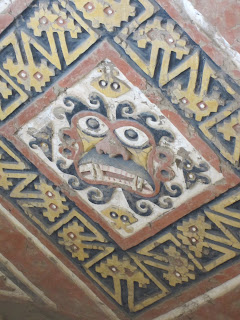This major Chilean port has been on my ’must do’ list since I
was about 8 – it’s hard to explain why – but at least visiting it has realised that
dream in a very delightful way.
Most ports are a bit tatty almost anywhere in the world and
we rather like that slightly run down, but colourful character they retain -
and Valparaiso certainly did not let us down.
 |
| Colourful buildings; Naval Headquarters Museum at top |
It retains a strong Naval identity – developed in part by an
Englishman called Lord Thomas Cochrane in the early 1800s just after Chile’s
independence from Spain. He based its structure on the British Navy and
elements of that remain today. Chile is a ‘shoe-string’ country with an
enormous coastline in relation to its land area and the British Naval sentiment
that you cannot be a master of your country unless you are also a master of
your seas continues here.
 |
| Naval Headquarters - Main CitySquare |
Valparaiso is also the birthplace of John Christian (Chris) Watson
(1867 – 1941) Australia’s 3rd (and first Labour) Prime Minister - for
a few months in 1904.
It’s built over a number of hills rather like San Francisco and
in common with that city is subject to earthquakes: both cities suffered devastating
earthquakes in 1906 and Valparaiso continues to do so, most recently in February 2010. It was granted UNESCO World Heritage status (again)
in 2003.
Although established in the 16th century by the
Spanish, it did not really get going until the Navy was established in 1818 and
worldwide trade routes were opened. Few
buildings survive from the pre 1906 earthquake – this is the oldest official
building from the 1850s with one of the original 1952 trolley buses – not a
great photo but you get the idea.
 |
| Contrast of downtown Valparaiso |
The city thrived from the mid 1850s but with opening of the Panama
Canal in 1914, things went downhill rather rapidly as clearly a new, shorter trade
route was available. In recent years however, the increase in the size of ships and the new Trans America Highway between Brazil and Chile has revived the port, though the effect of the opening of the new third (wider)
lock in 2014 in Panama is unknown.
 |
| View from Ascensore rail |
The shipping trade however also provided the city with its
building materials: the ships carrying saltpetre from Chile arrived with
ballast from Europe and America of Oregon pine, corrugated iron and stone. These built the houses and roads respectively
– even the most elegant of houses has corrugated iron facades reminiscent to
us of both Kalgoorlie and Broken Hill – and the Oregon pine was certainly
featured in Fremantle for probably the same reason.
 |
| Corrugated iron elegance? |
Unlike the more Northern countries of South America, the
part of South America was fairly sparsely populated pre Spanish conquest. This meant that people of many nationalities
settled here and this is reflected in the mish-mash of architectural styles,
food and people that make it so endearing.
Despite its Heritage listing some of the colour restrictions that apply
to some sites in the world are not enforced in Valparaiso. The houses were generally painted with
whatever paint was left over from repairing a ship in port and this still
applies today.
 |
| Variety is the spice.... |
To add to the character, there are funny little ‘ascensores’
– funicular railways – that get everyone around the steep streets. There are
still 12 operating today and people use them with the indifference of using a
pedestrian crossing – a trip is about 30 cents.
 |
| Ascensore funicular railway |
 |
| The oldest ascensore station in Valparaiso |
Sadly, many of these
photos were taken in the morning when it was cloudy, but bright sunshine from
noon highlighted the cities vibrancy even more.
It’s not a spot for everyone – dogs roam the streets at will, building maintenance is optional, graffiti really is everywhere, wiring haphazard and the always
impending earthquakes could be off putting but we, and many others, can’t wait to
return.
 |
| Delightful disrepair |
We’re on our way to Puerto Montt still in Chile and potentially the start of true cold
weather – we’re already further south than I have ever been. It will be our first tender port (where the ship drops anchor and then you climb on a smaller boat to get ferried in, I didn't realise what that meant before) – what fun!
























































